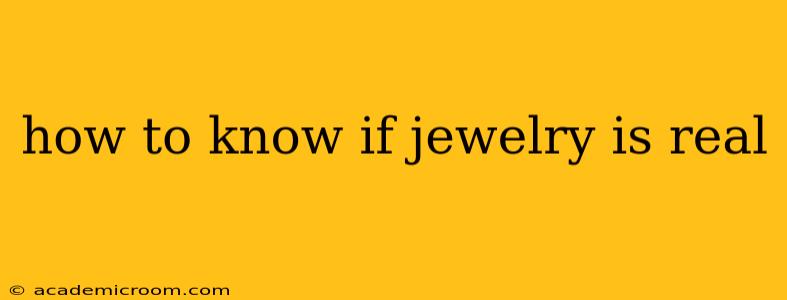Determining the authenticity of jewelry can be tricky, especially with the proliferation of high-quality counterfeits. This comprehensive guide will equip you with the knowledge and techniques to distinguish real gold, silver, platinum, and precious gemstones from their imitations. Whether you're a seasoned collector or a first-time buyer, understanding these methods will save you from costly mistakes and ensure you're investing in genuine pieces.
What are the hallmarks of genuine jewelry?
Genuine jewelry often features hallmarks, which are small stamps indicating the metal's purity and origin. These hallmarks vary by country, but generally include a number representing the karat (for gold) or fineness (for silver and platinum), and sometimes a maker's mark. Look carefully for these tiny imprints, usually located on the clasp, inside a ring band, or on the earring post. The absence of hallmarks doesn't automatically mean the piece is fake, as some smaller pieces or antique jewelry may lack them, but it's a strong indicator to investigate further.
How can I test jewelry for authenticity at home?
Several at-home tests can offer clues about a piece's authenticity, though they shouldn't be considered definitive proof.
Magnet Test:
This is a simple first step. Gold, silver, and platinum are not magnetic. If a magnet strongly attracts your jewelry, it's almost certainly not made of these precious metals. However, remember that some gold alloys can exhibit slight magnetic properties, so this test should be used in conjunction with others.
Acid Test:
This test is more involved and requires purchasing a jeweler's testing kit, which includes various acids that react differently with different metals. These kits are relatively inexpensive and widely available online. It's crucial to follow the instructions precisely, as improper use can damage your jewelry.
Density Test:
This method is more scientific and involves measuring the jewelry's weight and volume to calculate its density. Each metal has a specific density. While this provides a more accurate measure, it requires specialized tools and knowledge.
Visual Inspection:
Closely examining the piece for imperfections or inconsistencies is crucial. Look for inconsistencies in color, unusual markings, or poor craftsmanship. Real gemstones often exhibit natural inclusions (tiny imperfections), while fakes often appear flawless.
What are the common signs of fake jewelry?
Several indicators can suggest your jewelry is not genuine:
- Unusually low price: If a piece seems too good to be true, it likely is. Precious metals and gemstones are expensive; significantly discounted prices should raise a red flag.
- Flawlessly perfect stones: Natural gemstones rarely possess perfect clarity and often exhibit subtle inclusions or variations in color.
- Poor craftsmanship: Examine the piece carefully for uneven surfaces, rough edges, or loose settings.
- Lack of hallmarks: While not always definitive, the absence of hallmarks can suggest a lack of authenticity.
- Unusual weight: Compare the weight of your piece to similar items known to be authentic. A significantly lighter or heavier piece could indicate that it is not made of the stated metal.
How can I tell if my diamonds are real?
Diamonds possess specific optical properties that can be used to verify their authenticity.
- Diamond Tester: A diamond tester uses thermal conductivity to distinguish diamonds from simulants. Diamonds conduct heat much more efficiently than most imitations.
- Magnification: Examine the stone under magnification. Real diamonds often exhibit minute inclusions, while flawless stones are often suspicious.
- Professional Appraisal: The most reliable way to determine a diamond's authenticity is through a professional gemologist's appraisal. This is especially important for larger or more valuable stones.
What about other gemstones?
Authenticating other gemstones requires a similar approach, utilizing visual inspection, gemological testing, and potentially a professional appraisal. The characteristics and properties of each gemstone vary, demanding specialized knowledge for accurate identification.
How to find a reputable jeweler?
Buying from a reputable jeweler is the best way to ensure you're purchasing authentic jewelry. Look for jewelers with established reputations, positive reviews, and a willingness to provide certificates of authenticity.
By combining these methods and exercising due diligence, you can significantly increase your chances of acquiring genuine, high-quality jewelry. Remember, when in doubt, always seek the expertise of a qualified gemologist or jeweler.
